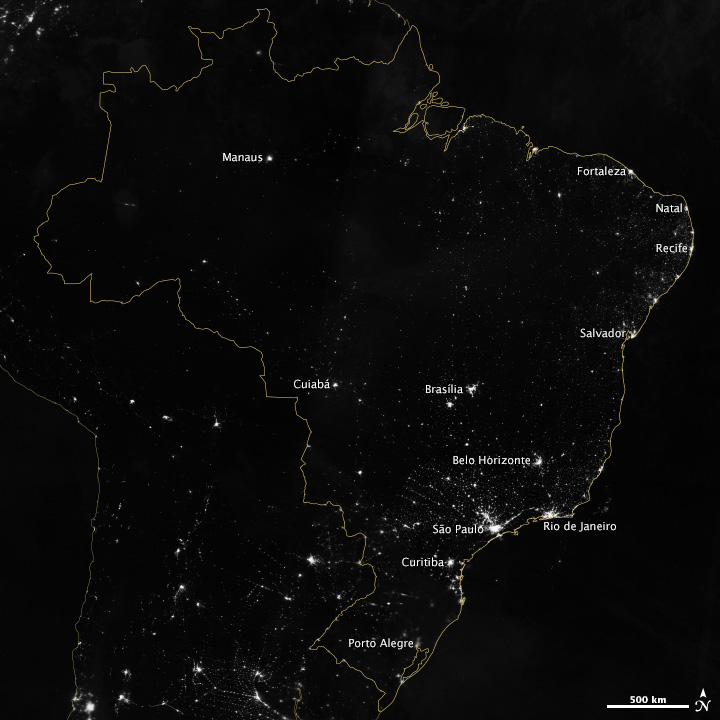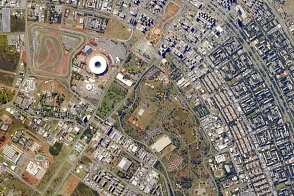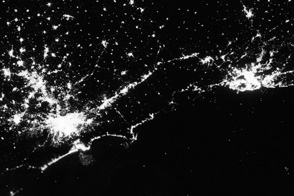


On June 12, 2014, the most-watched sporting event in the world will kickoff at Arena Corinthians in São Paulo. Sponsored by the Fédération Internationale de Football Association (FIFA), the world championship of soccer (football) includes 32 teams vying for a spot in the final on July 13 in Rio de Janeiro. The World Cup is being hosted by Brazil for the first time since 1950.
Home to roughly 190 million people, Brazil is the largest country in South America and the fifth largest in the world by area (8.5 million square kilometers). As shown in the image above, Brazil stretches more than 4,000 kilometers (2500 miles) from north to south and from east to west. The coastal cities of São Paulo and Rio de Janeiro (second image) highlight the most densely populated part of the country. In 2014, twelve Brazilian cities will host games, including Brasília, Belo Horizonte, Manaus, Fortaleza, Cuiabá, Porto Alegre, Curitiba, Natal, Recife, Salvador, Rio de Janeiro, and São Paulo.
The World Cup is being held for the 20th time since its first installment in 1930. The global tournament has been held every four years, with the only break coming in the days of World War II. The Brazilian national team has been to the final game seven times, winning five, most recently in 2002.
The Visible Infrared Imaging Radiometer Suite (VIIRS) on the Suomi NPP satellite captured the images on August 4, 2013. The nighttime view was made possible by the VIIRS “day-night band,” which detects light in a range of wavelengths from green to near-infrared and uses light intensification to enable the detection of dim signals. The instrument can sense light 100,000 times fainter than conventional visible-light sensors, making it very sensitive to moonlight and city lights.
Unlike a film camera that captures a photograph in one exposure, VIIRS produces an image by repeatedly scanning a scene and resolving it as millions of individual picture elements, or pixels. The day-night band goes a step further, determining on-the-fly whether to use its low, medium, or high-gain mode. If a pixel is very bright, a low-gain mode on the sensor prevents the pixel from over-saturating. If the pixel is dark, the signal will be amplified.
NASA image by Marit Jentoft-Nilsen and Robert Simmon, using VIIRS Day-Night Band data from the Suomi National Polar-orbiting Partnership. Suomi NPP is the result of a partnership between NASA, the National Oceanic and Atmospheric Administration, and the Department of Defense. Caption by Mike Carlowicz.
Image of the Day Unique Imagery Human Presence
Twelves cities in South America’s largest country will host games in the 2014 World Cup of football (soccer).
Image of the Day for June 13, 2014
Brazil is hosting the 2014 FIFA World Cup soccer (football) championship. Twelve cities will host games between June 12 and July 13.

